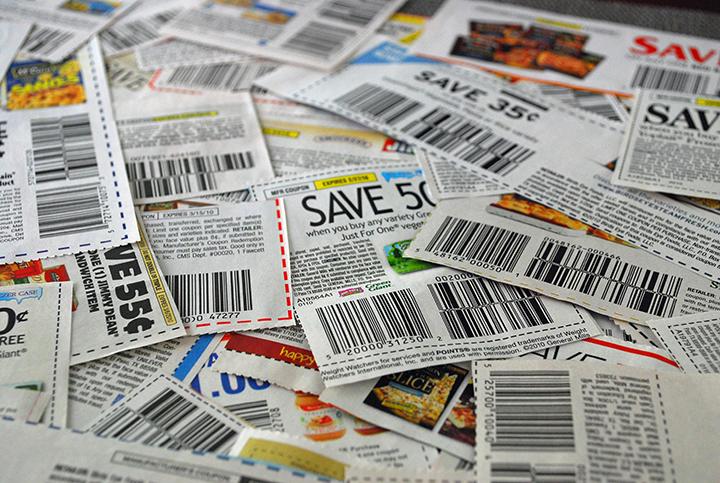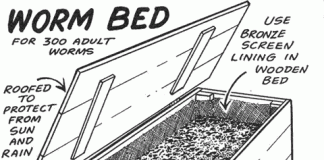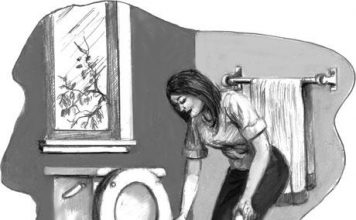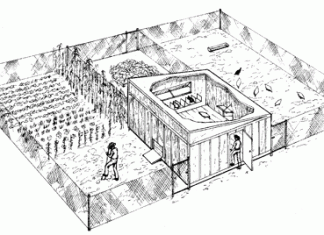| Issue #92 • March/April, 2005 |
Seven years ago, when my brother John helped us move into our current country home, he commented wryly, “If you ever fill those cupboards upstairs I don’t want to help you move again.” Once a sickroom in the older brick home, someone had converted it into wall to wall cupboards and drawers. Now, seven years later, not only are the cupboards full, but I’ve managed to fill each and every nook and cranny of our spacious home and the stockpiling has spilled into our hallways.
Open one of the cupboards and you’d see neatly stacked gift items waiting for Christmas or one of the birthdays of my eight children, son-in-law, or my granddaughter. I add to this stash year-round as I find gifts on clearance or at sidewalk sales. Open any of the other cupboards and you’d think you had just stepped into a discount store; dozens of deodorants, toothpaste, body washes, and bottles of shampoo are stored inside. Drawers hold toothbrushes, razors, and band-aids. Packages of toilet paper are stacked neatly behind the closet door, and in a pyramid in the hallway. Kitchen cupboards are packed with canned goods and bagged cereal.
Y2K fanatic? Compulsive shopper? No, this is something more insidious, something I have been doing since getting married as a college student, 25 years ago, and that has become more of a necessity since the births of eight children. In a home where it is not unusual to go through a tube of toothpaste and a bottle of shampoo each week, my method of stockpiling using coupons has become a defense mechanism against the high cost of living. While my country living female peers spend hours laboring over their hot stoves in the August heat to preserve their harvest I would more likely be found in an air-conditioned store clearance aisle. While other women might be sewing their own clothing or making their own soap, I am just as likely to be finding clothing for my family at a 25-cents thrift store tag sale and getting my soap free during my weekly trip into town. As a busy homeschooler, freelance writer, and book seller, I choose to spend at least one day a week combining my usual book hunt with shopping sprees at discount stores and thrift stores. And I’ve found a different way to fill my shelves with very little money invested. I use coupons!
|
I started using coupons when I got married in 1979 and wanted to save money on our paltry $20 a week grocery bill. My use of coupons has increased exponentially with the births of each of our children. By child number four I wasn’t just saving 40 percent off at the grocery store with coupons, I was also sending in for nearly $100 a month on refunds on the products I bought. For years I had access to double couponing and started stockpiling the products I was getting for free or nearly free with coupons. I replenished my supply of coupon inserts weekly at the local recycling center. For a few years, most of my Christmas shopping consisted of free premiums from refund offers and my files of UPCs and product packaging. My children loved their free tee shirts, stuffed animals, radios, and balls.
Those were the heyday years for refunders and couponers alike. Refund offers now require specifically dated receipts and it has been several years since I lived near a friendly recycling center or a store that doubled coupons. In the past few years my greatest savings have come through combining clearance or sale prices with high-value coupons. Each time I enter a discount or grocery store I search for clearance shelves or baskets. As a homeschooling family we attend a lot of book sales in towns within a 50-mile radius. We often stop at local discount stores in those towns and search their clearance aisles with my large coupon box in tow. It is not unusual for me to empty a shelf of clearance deodorant and walk out of a store paying only the tax or a few cents for my cart-full.
Stockpiling is smart shopping, especially if you have a large family as I do, and you might already be doing it on a small-scale, buying several of a product when it goes on sale. But stockpiling is even smarter when you are combining coupon savings with those sale prices. Getting started in couponing, refunding, and stockpiling is easy, and you can get as involved as you want, using a few coupons a week, or doing it as a part-time hobby as I do. My job as a stay-at-home mother is to make sure our meager budget stretches as far as possible.
Getting organized
Some advice to get you started in couponing and stockpiling;
1) Clip and save every high-value coupon, even if it is for something you don’t normally use.
Buy a Sunday paper and clip the coupon inserts faithfully. If there is a coupon on a product you always use or a high-value coupon on something you often see on sale, ask for extra coupon inserts from neighbors, friends, relatives or co-workers. Ask the librarian at your local library if you can have the inserts from their papers. You can even go online and order more of the coupons on eBay.com or other sites. Never pay more than 10 cents on the dollar for your coupons or it just defeats the purpose of using coupons to save money in the first place. I have paid as much as a dollar for a coupon worth $7.99, but normally pay a 10-cent fee per $1 coupon.
There are also websites for couponers to trade coupons, such as www.Kachinaweb.com or www.Refundcents.com. One area of the country might have a $1 coupon available, whereas another might have a “Buy One, Get One Free” coupon out. I’ve traded $2 dishwasher detergent coupons for $1 dish soap coupons since I don’t have a dishwasher, so now I have shelves of the dish soap I can use. And the 40 bottles stored away were free because of trading.
The reason for buying or trading for multiples of coupons you would use? You never know when you might stumble across a clearance aisle or sale on an item marked down low enough to get it free or for pennies with the coupon. Or, if it is a product you use a lot of, you will want more than one coupon so you can buy several when it is on sale.
2) Keep your coupons organized.
All that clipping and sorting into categories isn’t going to do you any good if you forget to bring your coupons with you when you go to the store. Most discount stores sell coupon holders with built-in dividers and these are wonderful when you are just starting out. You will soon outgrow that size, though, and want to invest in something bigger, like a large plastic shoebox holder with index cards between the categories. Some coupon users like to organize their coupons in school binders with the clear sports card holders for organizing their coupons. You can also buy a plastic box made specifically for coupons. My favorite is sold at www.Refundcents.com. This site also has information about using the binder method of coupon organization, as well as trading boards and information on saving money in other ways.
3) Keep an eye on weekly sale ads.
Besides the coupon inserts, the ads section is the first thing I read each Sunday. When my favorite razors go on sale for half-price and I have 20 $2-off coupons, that’s the time to use my coupons. Learn which stores price-match and take all your ads to that store so you don’t have to run all over town bagging your bargains. Watch for Free After Rebate (FAR) items, and don’t forget to use your coupon on those, and send for the rebate, too. Stores like Walgreens and Rite-Aid have monthly rebate booklets and if you shop right you should be able to make a monthly profit by using coupons on their FAR items. Some stores let you use your manufacturer’s coupons along with their store coupons for even more savings. I recently stocked up on a particular brand of shampoo the store had a $1.50 coupon for, and for which I also had $1 manufacturer’s coupons. Final tally? 20 bottles of shampoo for tax only!
4) Always check clearance aisles and reduced bins.
I have gotten some of my best deals on marked down health and beauty items, getting products for free or for a few pennies each using coupons on clearanced products. While my family might prefer one brand of deodorant, I’m not going to pass up 10-cent deodorant and can always sell some at a garage sale, donate to a food pantry or shelter (they don’t ever get enough of that kind of product), or allow my adult children to raid my closet once in awhile. Last year I filled a big basket with extra items as one of their Christmas gifts. After filing her own cupboards last year with my gifts, my oldest daughter, Elizabeth, decided she, too, wanted to start stockpiling and has started her own coupon file.
5) Stock up on the cheapest items and find a place for storage of stockpiled items.
If you find shampoo marked down to $1 a bottle, and you have 20 $1-off coupons in your coupon box, buy 20 bottles. If you don’t have extra cupboard or closet space, you can store Rubbermaid-type containers full of shampoo in your own closet or even under your bed. If you are worried about the shelf life of some of the stored products, call the toll-free numbers listed on the packages for information on expected shelf life. I rotate my stockpile of things like toothpaste, making sure we use the oldest tubes first.
I will admit my children got tired of a brand of bagged cereal when I came home with 30-plus bags for free with my coupons several months ago. I still have some left and while they don’t want it for breakfast anymore, I am sure that after another week or two of hot cereal or muffins they will be happy to enjoy the treat of cold cereal again.
6) Don’t forget the rebates.
Coupon inserts have refund forms amongst the coupons and you can often find FAR offers directly on the products and packaging, especially on the new products that come out. Good coupons in the inserts on a new product will come out about the same time a rebate does, so a wise use of your coupon combined with the refund sometimes means you actually make money on the product. Send for your refund immediately when you get home from the store so you don’t forget, and don’t forget to ask for a separate receipt if you are buying more than one product for a refund because you will need separate receipts for each.
7) Think outside of the box regarding uses for your stockpiles.
I recently traded a box full of soaps, cleaners, and toothpaste for a goat for my daughter. I let the owner of the goat raid my cupboards and choose what she estimated was worth the $25 goat price to her. I have also filled baskets with extra bath soaps and deodorants as Christmas gifts. My siblings were thrilled last year to get a new shower puff along with 10 bottles of shower soap. My cost for the gift? Only $1.59 for the body puff.
Does this sound like too much work? That’s the complaint I most often hear when I share the details of my couponing/refunding lifestyle. “It’s just pennies,” one sister commented, “I don’t have time for that.” Maybe so, but I regularly save 2000 to 3000 pennies at the grocery store each week and even more at the discount stores with my coupons. Those “pennies” really add up. And my family knows if they run out of something liked deodorant, toothpaste, or shampoo, there’s more where that came from in a cupboard just a few steps away. And the best thing of all? It was either free or nearly free.















